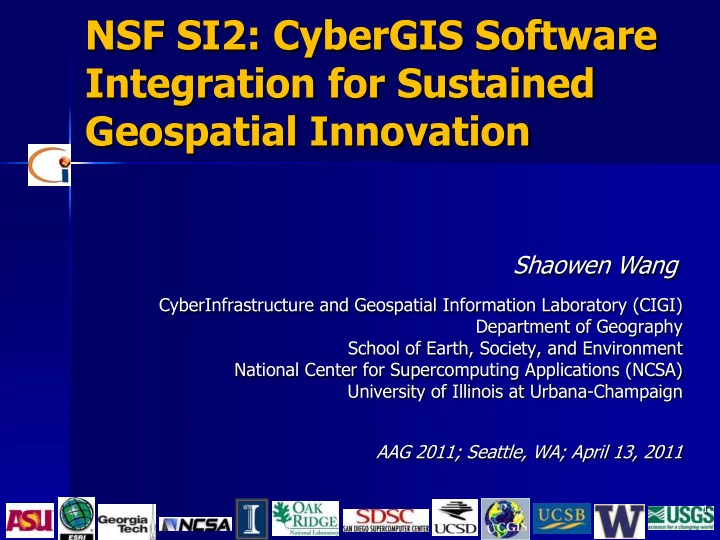

NSF SI2: CyberGIS Software Integration for Sustained Geospatial Innovation Shaowen Wang CyberInfrastructure and Geospatial Information Laboratory (CIGI) Department of Geography School of Earth, Society, and Environment National Center for Supercomputing Applications (NCSA) University of Illinois at Urbana-Champaign AAG 2011; Seattle, WA; April 13, 2011 1
Acknowledgements NSF Software Infrastructure for Sustained Innovation (SI2) Program – 5-year, $4.4 million This material is based in part upon work supported by NSF under Grant Number OCI- 1047916 Any opinions, findings, and conclusions or recommendations expressed in this material are those of the author(s) and do not necessarily reflect the views of the National Science Foundation 2
Project Team Senior Personnel Principal Investigators – Shaowen Wang – Michael Goodchild PI – Sergio Rey – Luc Anselin – Xuan Shi Co-PI – Marc Snir – Budhendra Bhaduri – E. Lynn Usery Co-PI Project Staff and Students – Timothy Nyerges – ASU: Mark McCann Co-PI – ORNL: Ranga Raju Vatsavai – Nancy Wilkins-Diehr – SDSC: Christopher Crosby and Co-PI Sriram Krishnan UIUC: Yan Liu and Anand Industrial Partner: ESRI – – Steve Kopp Padmanabhan – A number of graduate and undergraduate students 3
What is the specific need(s) addressed and how the development and use of CyberGIS software will have an impact? Needs – Analyzing massive spatiotemporal data – Solving geospatial problems that are computationally intensive and require collaboration support Impact – Innovate new geographic information systems software that is high-performance and scalable, distributed, collaborative, service-oriented, user-centric, and community-driven – Achieve groundbreaking scientific breakthroughs in understanding the complexity of coupled human-natural systems 4
Overarching Goal Establish CyberGIS as a fundamentally new software framework comprising a seamless integration of cyberinfrastructure, GIS, and spatial analysis and modeling capabilities and, thus, promises widespread scientific breakthroughs and broad societal impacts 5
“If infrastructure is required for an industrial economy, then we could say that cyberinfrastructure is required for a knowledge economy.” (Atkins et al. 2003) 6
CyberGIS – In a Nutshell Software Integration After Wang (2010) Wang, S. 2010. “A CyberGIS Framework for the Synthesis of Cyberinfrastructure, GIS, and Spatial 7 Analysis.” Annals of the Association of American Geographers, 100(3): 535 -557
What are the specific software elements/infrastructure that are developed? Online CyberGIS Gateway: https://gisolve2.cigi.uiuc.edu:8443/home/ (prototype release) CyberGIS Toolkit 8
9
What are the potential broader impacts of the software beyond the targeted communities? Help general public better understand spatial decision making processes Contribute to other similar fields of study that require the synthesis of and interactions among domain-specific modeling capabilities across multiple spatiotemporal scales 10
Research Plan Participatory Evolution of CyberGIS Community Requirements CyberGIS Software Integration Roadmap High Performance and Scalable CyberGIS Online CyberGIS Gateway CyberGIS Testing and Integration with National and International Cyberinfrastructure Community-Based and Application-Driven Evaluation of CyberGIS 11
Software Capabilities and Interfaces – Starting Points GISolve GeoDa / Open- PGIST pd- PySAL Topography GRASS ∆ ◊ Agent-Based Modeling (ABM) ∆ □ Choice modeling ∆ □ ◊ ∆ □ ◊ ○ Domain-specific modeling ∆ □ ◊ Geostatistical modeling GIS/SAM ∆ □ ◊ ∆ □ ◊ ○ Local clustering detection ∆ □ ◊ ○ ∆ □ ◊ ○ Spatial interpolation ∆ □ ◊ ○ Spatial econometrics ∆ ◊ ○ ∆ □ ◊ ○ ∆ □ ◊ ∆ ◊ ○ ∆ □ ○ Visualization & map operations ∆ □ ◊ ○ Spatial middleware ∆ □ ◊ ○ ∆ □ ○ Generic CI capabilities ∆ □ ◊ ○ ∆ □ ◊ Online problem-solving ∆User interface □ API &Library ◊ Service ○ Open source 12
CyberGIS (www.cybrergis.org) A collaborative software framework encompassing many research fields Assessment of climate change impact Emergency management Seamless integration of cyberinfrastructure, GIS, and spatial analysis and modeling Capable of handling huge volumes of data, complex analysis and visualization required for many challenging applications Empower high-performance and collaborative geospatial problem solving Gain fundamental understanding of scalable and sustainable geospatial software ecosystems 13
CIGI – CyberInfrastructure and Geospatial Information Laboratory / Virtual-Organization Energy, Applications Environment, Multidisciplinary Interactions Health Spatial Analysis and Spatial Knowledge of Modeling Computational Intensity High-Performance, Distributed GISolve and Collaborative GIS Extreme-scale Base Computing, Open Cyberinfrastructure Science Grid, TeraGrid 14
Science Impact
Recommend
More recommend